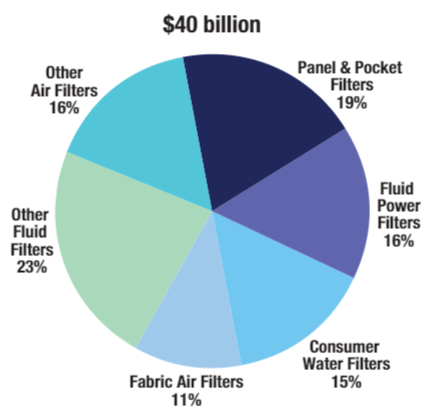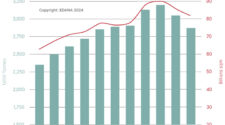The $40 billion global filtration market is forecast to grow 4% per year through 2022. Fluid filters have favorable growth prospects because of increasing concerns about pollution; the introduction of new, state-of-the-art filtration technologies; the expansion of public infrastructures around the world; and increasing consumer interest in a wide range of filtration products.
The adoption of more stringent air and water quality standards will encourage the use of many filtration technologies as well. During the last decade, our understanding of the short and long-term harms caused by pollution evolved rapidly, heightening concerns about air and water quality. Attesting to the prevalence of the problem, the World Health Organization found that over 90% of people worldwide reside in areas with air pollution levels above guideline limits and that more than 4 million people die annually from exposure to ambient air pollution. In addition, recent research has also linked pollution to declining mental health, rising crime, poor test scores and weight gain.

China exemplifies the greater focus being placed on containing pollution. The country has sought to reduce the harm of air pollution by:
- Imposing more demanding vehicle and factory emissions standards
- Cracking down on both lax enforcement practices by local authorities through a national inspection system
- Investing in green energy and advanced filtration technologies
- Partnering with other governments and organizations to address environmental goals
The diverse fluid filters segment – which includes fluid power filters, consumer water filters, and fluid filters used in municipal and industrial applications – will grow to $25 billion by 2022. Advances in global manufacturing activity and the expansion of the world’s stock of industrial machinery and mobile equipment will drive fluid power filter sales. Household spending on consumer filters in many countries will increase through 2022 as personal incomes rise and more people become aware of the impact of water pollution. Government efforts to upgrade and expand public utilities, and the growing use of filters in industrial fluid treatment and chemical and pharmaceutical production will also contribute to gains.
The global market for air filters is expected to exceed $22 billion by 2022. Panel and pocket air filters – which are used in HVAC systems, single-room air conditioners, and portable air cleaners – are by far the most commonly used product type, accounting for more than 40% of air filter sales in 2019. Panel and pocket air filter demand is expected to grow by nearly 5% annually through 2022 because of increasing replacement filter requirements of North America, Europe, and Asia; rising HVAC system installation around the world; and increasing consumer demand for portable air cleaners.
Fabric air pollution filters – which accounted for about one-fourth of the global air filter market in 2019 – also have extensive growth potential. Global sales of fabric air pollution filters will climb as manufacturers and power plant operators work to comply with more demanding air quality standards
Regulatory activity by governments around the world will have a profound impact on the filter market as well, forcing industry participants to have forward-looking growth strategies.
Learn about Freedonia’s Global Filters report, visit freedoniagroup.com/industry-study/global-filters-3711.htm.










